(October 4, 2001) --
When Compaq introduced the iPAQ early last year, it was met with a chorus of
criticism by naysayers who decried its lack of an internal expansion slot. No
Pocket PC device could succeed without one, they said. And Compaq's expansion
sleeve solution was too big and bulky.
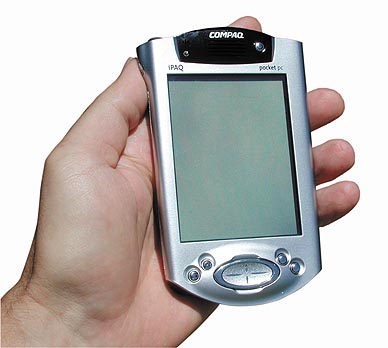 They may have had a point with the latter (though Compaq is now addressing that
shortcoming with a new family of sleeves) but they were way off in their
assessment of the iPAQ itself. The device went on to become far and away the most
successful Windows-powered handheld ever. In fact, it even replaced the sleek
Palm Vx as the most desirable and most wanted PDA in the eyes of many.
They may have had a point with the latter (though Compaq is now addressing that
shortcoming with a new family of sleeves) but they were way off in their
assessment of the iPAQ itself. The device went on to become far and away the most
successful Windows-powered handheld ever. In fact, it even replaced the sleek
Palm Vx as the most desirable and most wanted PDA in the eyes of many.
The original iPAQ was definitely a landmark design. Compaq had taken a gamble by
choosing an indoor/outdoor-readable reflective color display to go up against the
bright and gorgeous TFTs used by Casio. A gamble because the first generation of
such display was little more than a technology demonstration and definitely a
compromise in day-to-day use. The gamble paid off as the reflective TFT
technology had matured to a point where the display was good enough indoors in
addition to being near perfect outdoors. All of a sudden, it was the
competition's indoor-only TFTs that appeared to be a compromise. The expansion
strategy gamble likewise paid off. After a rough beginning where expansion
sleeves were nearly impossible to find, it became obvious that people liked the
flexibility of multi-format expansion sleeves. In addition, including a separate
battery into the PC Card sleeve was a stroke of genius as it allowed the use of
many high-draw PC Card peripherals without affecting the battery life of the iPAQ
itself. Finally, the iPAQ's design was sleek and different, and definitely a
winner. So at the occasion of Microsoft's unveiling of Pocket PC 2002, what could
Compaq possibly change on its successful PDA?
 The answer is "Not much." The screen, expansion strategy, and overall design were
definitely on the mark, and the iPAQ already had Flash ROM which makes it the
only device easily upgradeable to a new rev of the operating system. However,
there were a few areas where the original iPAQ was lacking. Its internal
Lithium-Polymer battery, for example, didn't provide the battery life expected.
The frontal navigation disc looked great but really didn't work very well,
probably because it was mounted on top of the iPAQ's speaker. And while expansion
sleeves are great, now that those tiny SD (Secure Digital) cards are available,
it wouldn't hurt to have a slot for them, in addition to the sleeves. Finally,
after having had 64k color on the old Aero 2100 Series, the iPAQ's mere 4.096
colors seemed weak.
The answer is "Not much." The screen, expansion strategy, and overall design were
definitely on the mark, and the iPAQ already had Flash ROM which makes it the
only device easily upgradeable to a new rev of the operating system. However,
there were a few areas where the original iPAQ was lacking. Its internal
Lithium-Polymer battery, for example, didn't provide the battery life expected.
The frontal navigation disc looked great but really didn't work very well,
probably because it was mounted on top of the iPAQ's speaker. And while expansion
sleeves are great, now that those tiny SD (Secure Digital) cards are available,
it wouldn't hurt to have a slot for them, in addition to the sleeves. Finally,
after having had 64k color on the old Aero 2100 Series, the iPAQ's mere 4.096
colors seemed weak.
Well, Compaq with the new H3800 Series, Compaq has addressed all of those
problems.
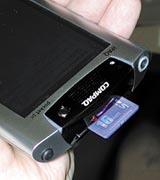 The H3800 has a SD card slot at the top of the device. Its internal
Lithium-Polymer received an almost 50% increase in capacity, from 950 mAh to
1,500 mAh. There is a totally redesigned nav disc that, while still not perfect,
works a whole lot better (the speaker has been relocated to a location above the
display). And the 3800's screen can now display 16-bit color, which means nearly
65,000 shades.
The H3800 has a SD card slot at the top of the device. Its internal
Lithium-Polymer received an almost 50% increase in capacity, from 950 mAh to
1,500 mAh. There is a totally redesigned nav disc that, while still not perfect,
works a whole lot better (the speaker has been relocated to a location above the
display). And the 3800's screen can now display 16-bit color, which means nearly
65,000 shades.
At first sight, the new iPAQ doesn't look very different from the original model.
The differences are reminiscent of the almost imperceptible styling changes
prestigious automobile makers like BMW or Mercedes Benz apply to their new
models: keep things new and fresh, but do not deviate from the trademark look
engrained in the consumers' minds. Compaq probably also didn't deviate too much
from the original design because the "old" model lives on in the form of the
H3700 series that benefits from minor modifications (primarily to accommodate
Pocket PC 2002) compared to the initial iPAQ.
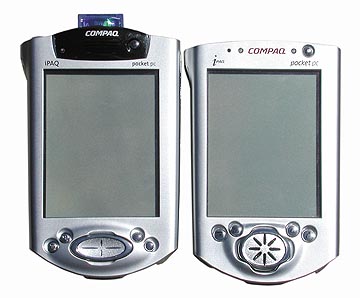 When you place the old and the new model side by side, you can see the subtle
differences. Most visible is the addition of a opaque piece of transparent
plastic (the kind that usually sits on top of IR ports) that wraps around the top
end of the device. On the front, the dark plastic lens is flanked by two
notification lights. The amber one on the right indicates charging status, while
a blue one on the left shows Bluetooth operation. Yes, some 3800 series models
come with a "Bluetooth" shortrange wireless radio. Also sitting inside the lens
are the speaker, the on-off switch, the light sensor that automatically adjusts
the display's sidelight, and the SD card slot. The new and elongated navigation
disc still has a somewhat mushy feel, but it now provides noticeable tactile
feedback in the form of a "click" when you press up, down, left, or right. The
four application buttons flanking the nav disc are smaller now. They wake up the
device when pushed, are software programmable, and have tiny icons on them. The
icons are too small to really be read, but as long as the buttons have default
functions I suppose they must have some sort of marking. The left and the right
side are totally unchanged, as is the bottom of the device, with one notable
exception: the power jack and the troublesome hard reset are gone. More on that
later. Another difference is the placement of the display. It sits lower in the
new iPAQ's housing, likely to make room for the addition of the multi-function
lens. The new placement makes the screen look slightly smaller but that is an
optical illusion.
When you place the old and the new model side by side, you can see the subtle
differences. Most visible is the addition of a opaque piece of transparent
plastic (the kind that usually sits on top of IR ports) that wraps around the top
end of the device. On the front, the dark plastic lens is flanked by two
notification lights. The amber one on the right indicates charging status, while
a blue one on the left shows Bluetooth operation. Yes, some 3800 series models
come with a "Bluetooth" shortrange wireless radio. Also sitting inside the lens
are the speaker, the on-off switch, the light sensor that automatically adjusts
the display's sidelight, and the SD card slot. The new and elongated navigation
disc still has a somewhat mushy feel, but it now provides noticeable tactile
feedback in the form of a "click" when you press up, down, left, or right. The
four application buttons flanking the nav disc are smaller now. They wake up the
device when pushed, are software programmable, and have tiny icons on them. The
icons are too small to really be read, but as long as the buttons have default
functions I suppose they must have some sort of marking. The left and the right
side are totally unchanged, as is the bottom of the device, with one notable
exception: the power jack and the troublesome hard reset are gone. More on that
later. Another difference is the placement of the display. It sits lower in the
new iPAQ's housing, likely to make room for the addition of the multi-function
lens. The new placement makes the screen look slightly smaller but that is an
optical illusion.
Also changed is the stylus. It is slightly shorter and rounder, and the
occasionally troublesome button release of the original iPAQ is gone. The stylus
compartment is now springload. You push on the pen to make it pop out.
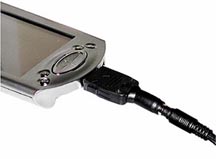 So what happened to the AC jack on the device? It is no longer needed because
Compaq switched to an entirely different power supply arrangement. The AC adapter
now either plugs into the cradle or, via an adapter, directly into the docking
connector. The docking connector itself is slightly wider and has 22 pins instead
of the initial iPAQ's 12 pins, and the 3800 will not fit into older docking
stations. Even if the connector were the same, the dock's plastic cone that fits
into the older iPAQ's AC jack has nowhere to go, thus preventing its use with the
new model. The dock's changed in other ways as well. It now has a cable with two
leads, one with a USB connector, the other a serial connector. Overall, I think I
prefer the old arrangement. Most people will eventually lose the small power
cable adapter, which means they'll only be able to charge their iPAQ via cradle.
And the dual cable adds a lot of bulk. I hope Compaq will offer different
cradles.
So what happened to the AC jack on the device? It is no longer needed because
Compaq switched to an entirely different power supply arrangement. The AC adapter
now either plugs into the cradle or, via an adapter, directly into the docking
connector. The docking connector itself is slightly wider and has 22 pins instead
of the initial iPAQ's 12 pins, and the 3800 will not fit into older docking
stations. Even if the connector were the same, the dock's plastic cone that fits
into the older iPAQ's AC jack has nowhere to go, thus preventing its use with the
new model. The dock's changed in other ways as well. It now has a cable with two
leads, one with a USB connector, the other a serial connector. Overall, I think I
prefer the old arrangement. Most people will eventually lose the small power
cable adapter, which means they'll only be able to charge their iPAQ via cradle.
And the dual cable adds a lot of bulk. I hope Compaq will offer different
cradles.
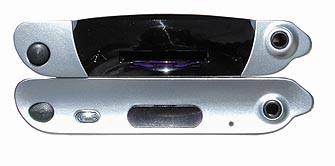 In terms of size and weight, the new device is virtually the same as the
original. The new one is slightly longer due to the plastic lens. Weight remains
at 6.5 ounces and width at 3.25 inches. The new iPAQ perfectly fits into all of
the old expansion sleeves.
In terms of size and weight, the new device is virtually the same as the
original. The new one is slightly longer due to the plastic lens. Weight remains
at 6.5 ounces and width at 3.25 inches. The new iPAQ perfectly fits into all of
the old expansion sleeves.
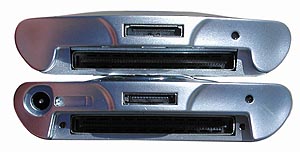 The larger capacity battery is definitely welcome. Battery life of the original
iPAQ was disappointing, lagging well behind, for example, my Casio EM500. A 50%
boost should improve the situation, especially since power consumption remains
unchanged. Compaq claims a 20% improvement. Unlike the new HP Jornada, however,
the iPAQ 3800 still doesn't have a backup battery. You can argue, of course, that
it doesn't need one since it doesn't have a removable main battery. In addition,
the 3800 has 6MB of Flash memory to store user data. In the HP Jornada, that area
is visible as "hp safe store." In the iPAQ it is accessible as "iPAQ File Store".
The larger capacity battery is definitely welcome. Battery life of the original
iPAQ was disappointing, lagging well behind, for example, my Casio EM500. A 50%
boost should improve the situation, especially since power consumption remains
unchanged. Compaq claims a 20% improvement. Unlike the new HP Jornada, however,
the iPAQ 3800 still doesn't have a backup battery. You can argue, of course, that
it doesn't need one since it doesn't have a removable main battery. In addition,
the 3800 has 6MB of Flash memory to store user data. In the HP Jornada, that area
is visible as "hp safe store." In the iPAQ it is accessible as "iPAQ File Store".
In terms of under the hood performance, there aren't any noticeable changes. The
3800 Series is still powered by the now ubiquitous 206 MHz Intel StrongARM SA1110
processor. Like all new iPAQs, the 3800 comes with 32MB of Flash ROM. Basic RAM,
however, is a generous 64MB whereas the 3700 Series is available with either 32
or 64MB. Benchmark performance of our pre-production review unit lagged slightly
behind that of a production iPAQ 3670. Performance of final units should be on
par with that of earlier iPAQs.
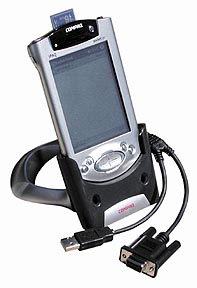 Unlike the base 3700 Series, the 3800s come with a generous additional software
bundle in addition to the standard Pocket PC 2002 and Compaq apps. There is voice
command and control for Calendar, Contacts, and Inbox; a data encryption package;
Insignia JVM (Java Virtual Machine); Quick View Plus; Eletel Message; eWallet;
ListPro, and additional games.
Unlike the base 3700 Series, the 3800s come with a generous additional software
bundle in addition to the standard Pocket PC 2002 and Compaq apps. There is voice
command and control for Calendar, Contacts, and Inbox; a data encryption package;
Insignia JVM (Java Virtual Machine); Quick View Plus; Eletel Message; eWallet;
ListPro, and additional games.
In summary, the new iPAQ H3800 Series builds on the strength and groundbreaking
design of the original iPAQ but also fine-tunes and enhances the original in some
much appreciated ways. Finally, Compaq addresses user two of the most urgent user
requests by adding an internal SD slot, and a more powerful battery. -


 They may have had a point with the latter (though Compaq is now addressing that
shortcoming with a new family of sleeves) but they were way off in their
assessment of the iPAQ itself. The device went on to become far and away the most
successful Windows-powered handheld ever. In fact, it even replaced the sleek
Palm Vx as the most desirable and most wanted PDA in the eyes of many.
They may have had a point with the latter (though Compaq is now addressing that
shortcoming with a new family of sleeves) but they were way off in their
assessment of the iPAQ itself. The device went on to become far and away the most
successful Windows-powered handheld ever. In fact, it even replaced the sleek
Palm Vx as the most desirable and most wanted PDA in the eyes of many.  The answer is "Not much." The screen, expansion strategy, and overall design were
definitely on the mark, and the iPAQ already had Flash ROM which makes it the
only device easily upgradeable to a new rev of the operating system. However,
there were a few areas where the original iPAQ was lacking. Its internal
Lithium-Polymer battery, for example, didn't provide the battery life expected.
The frontal navigation disc looked great but really didn't work very well,
probably because it was mounted on top of the iPAQ's speaker. And while expansion
sleeves are great, now that those tiny SD (Secure Digital) cards are available,
it wouldn't hurt to have a slot for them, in addition to the sleeves. Finally,
after having had 64k color on the old Aero 2100 Series, the iPAQ's mere 4.096
colors seemed weak.
The answer is "Not much." The screen, expansion strategy, and overall design were
definitely on the mark, and the iPAQ already had Flash ROM which makes it the
only device easily upgradeable to a new rev of the operating system. However,
there were a few areas where the original iPAQ was lacking. Its internal
Lithium-Polymer battery, for example, didn't provide the battery life expected.
The frontal navigation disc looked great but really didn't work very well,
probably because it was mounted on top of the iPAQ's speaker. And while expansion
sleeves are great, now that those tiny SD (Secure Digital) cards are available,
it wouldn't hurt to have a slot for them, in addition to the sleeves. Finally,
after having had 64k color on the old Aero 2100 Series, the iPAQ's mere 4.096
colors seemed weak.  The H3800 has a SD card slot at the top of the device. Its internal
Lithium-Polymer received an almost 50% increase in capacity, from 950 mAh to
1,500 mAh. There is a totally redesigned nav disc that, while still not perfect,
works a whole lot better (the speaker has been relocated to a location above the
display). And the 3800's screen can now display 16-bit color, which means nearly
65,000 shades.
The H3800 has a SD card slot at the top of the device. Its internal
Lithium-Polymer received an almost 50% increase in capacity, from 950 mAh to
1,500 mAh. There is a totally redesigned nav disc that, while still not perfect,
works a whole lot better (the speaker has been relocated to a location above the
display). And the 3800's screen can now display 16-bit color, which means nearly
65,000 shades.  When you place the old and the new model side by side, you can see the subtle
differences. Most visible is the addition of a opaque piece of transparent
plastic (the kind that usually sits on top of IR ports) that wraps around the top
end of the device. On the front, the dark plastic lens is flanked by two
notification lights. The amber one on the right indicates charging status, while
a blue one on the left shows Bluetooth operation. Yes, some 3800 series models
come with a "Bluetooth" shortrange wireless radio. Also sitting inside the lens
are the speaker, the on-off switch, the light sensor that automatically adjusts
the display's sidelight, and the SD card slot. The new and elongated navigation
disc still has a somewhat mushy feel, but it now provides noticeable tactile
feedback in the form of a "click" when you press up, down, left, or right. The
four application buttons flanking the nav disc are smaller now. They wake up the
device when pushed, are software programmable, and have tiny icons on them. The
icons are too small to really be read, but as long as the buttons have default
functions I suppose they must have some sort of marking. The left and the right
side are totally unchanged, as is the bottom of the device, with one notable
exception: the power jack and the troublesome hard reset are gone. More on that
later. Another difference is the placement of the display. It sits lower in the
new iPAQ's housing, likely to make room for the addition of the multi-function
lens. The new placement makes the screen look slightly smaller but that is an
optical illusion.
When you place the old and the new model side by side, you can see the subtle
differences. Most visible is the addition of a opaque piece of transparent
plastic (the kind that usually sits on top of IR ports) that wraps around the top
end of the device. On the front, the dark plastic lens is flanked by two
notification lights. The amber one on the right indicates charging status, while
a blue one on the left shows Bluetooth operation. Yes, some 3800 series models
come with a "Bluetooth" shortrange wireless radio. Also sitting inside the lens
are the speaker, the on-off switch, the light sensor that automatically adjusts
the display's sidelight, and the SD card slot. The new and elongated navigation
disc still has a somewhat mushy feel, but it now provides noticeable tactile
feedback in the form of a "click" when you press up, down, left, or right. The
four application buttons flanking the nav disc are smaller now. They wake up the
device when pushed, are software programmable, and have tiny icons on them. The
icons are too small to really be read, but as long as the buttons have default
functions I suppose they must have some sort of marking. The left and the right
side are totally unchanged, as is the bottom of the device, with one notable
exception: the power jack and the troublesome hard reset are gone. More on that
later. Another difference is the placement of the display. It sits lower in the
new iPAQ's housing, likely to make room for the addition of the multi-function
lens. The new placement makes the screen look slightly smaller but that is an
optical illusion.  So what happened to the AC jack on the device? It is no longer needed because
Compaq switched to an entirely different power supply arrangement. The AC adapter
now either plugs into the cradle or, via an adapter, directly into the docking
connector. The docking connector itself is slightly wider and has 22 pins instead
of the initial iPAQ's 12 pins, and the 3800 will not fit into older docking
stations. Even if the connector were the same, the dock's plastic cone that fits
into the older iPAQ's AC jack has nowhere to go, thus preventing its use with the
new model. The dock's changed in other ways as well. It now has a cable with two
leads, one with a USB connector, the other a serial connector. Overall, I think I
prefer the old arrangement. Most people will eventually lose the small power
cable adapter, which means they'll only be able to charge their iPAQ via cradle.
And the dual cable adds a lot of bulk. I hope Compaq will offer different
cradles.
So what happened to the AC jack on the device? It is no longer needed because
Compaq switched to an entirely different power supply arrangement. The AC adapter
now either plugs into the cradle or, via an adapter, directly into the docking
connector. The docking connector itself is slightly wider and has 22 pins instead
of the initial iPAQ's 12 pins, and the 3800 will not fit into older docking
stations. Even if the connector were the same, the dock's plastic cone that fits
into the older iPAQ's AC jack has nowhere to go, thus preventing its use with the
new model. The dock's changed in other ways as well. It now has a cable with two
leads, one with a USB connector, the other a serial connector. Overall, I think I
prefer the old arrangement. Most people will eventually lose the small power
cable adapter, which means they'll only be able to charge their iPAQ via cradle.
And the dual cable adds a lot of bulk. I hope Compaq will offer different
cradles.  In terms of size and weight, the new device is virtually the same as the
original. The new one is slightly longer due to the plastic lens. Weight remains
at 6.5 ounces and width at 3.25 inches. The new iPAQ perfectly fits into all of
the old expansion sleeves.
In terms of size and weight, the new device is virtually the same as the
original. The new one is slightly longer due to the plastic lens. Weight remains
at 6.5 ounces and width at 3.25 inches. The new iPAQ perfectly fits into all of
the old expansion sleeves.  The larger capacity battery is definitely welcome. Battery life of the original
iPAQ was disappointing, lagging well behind, for example, my Casio EM500. A 50%
boost should improve the situation, especially since power consumption remains
unchanged. Compaq claims a 20% improvement. Unlike the new HP Jornada, however,
the iPAQ 3800 still doesn't have a backup battery. You can argue, of course, that
it doesn't need one since it doesn't have a removable main battery. In addition,
the 3800 has 6MB of Flash memory to store user data. In the HP Jornada, that area
is visible as "hp safe store." In the iPAQ it is accessible as "iPAQ File Store".
The larger capacity battery is definitely welcome. Battery life of the original
iPAQ was disappointing, lagging well behind, for example, my Casio EM500. A 50%
boost should improve the situation, especially since power consumption remains
unchanged. Compaq claims a 20% improvement. Unlike the new HP Jornada, however,
the iPAQ 3800 still doesn't have a backup battery. You can argue, of course, that
it doesn't need one since it doesn't have a removable main battery. In addition,
the 3800 has 6MB of Flash memory to store user data. In the HP Jornada, that area
is visible as "hp safe store." In the iPAQ it is accessible as "iPAQ File Store".
 Unlike the base 3700 Series, the 3800s come with a generous additional software
bundle in addition to the standard Pocket PC 2002 and Compaq apps. There is voice
command and control for Calendar, Contacts, and Inbox; a data encryption package;
Insignia JVM (Java Virtual Machine); Quick View Plus; Eletel Message; eWallet;
ListPro, and additional games.
Unlike the base 3700 Series, the 3800s come with a generous additional software
bundle in addition to the standard Pocket PC 2002 and Compaq apps. There is voice
command and control for Calendar, Contacts, and Inbox; a data encryption package;
Insignia JVM (Java Virtual Machine); Quick View Plus; Eletel Message; eWallet;
ListPro, and additional games.